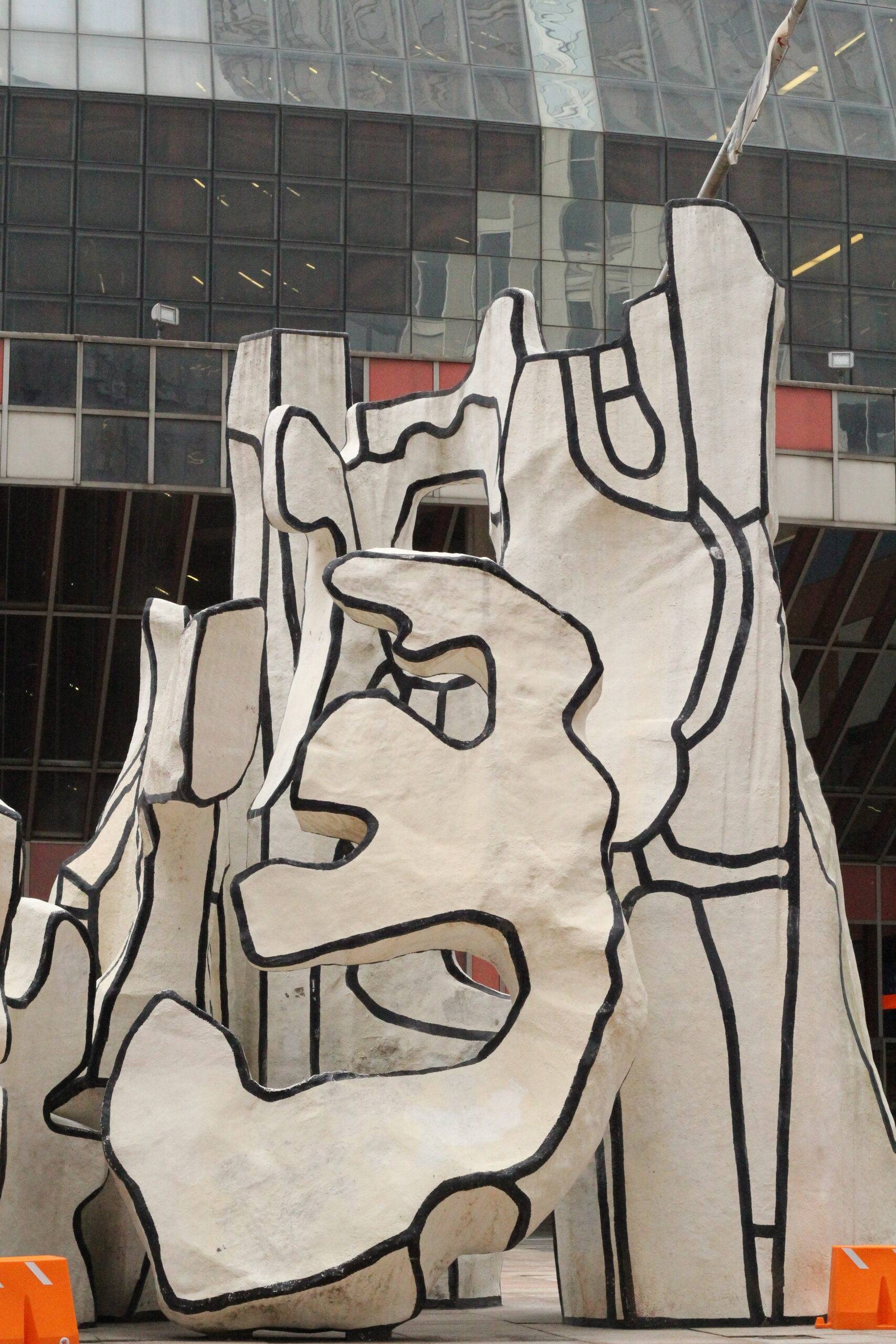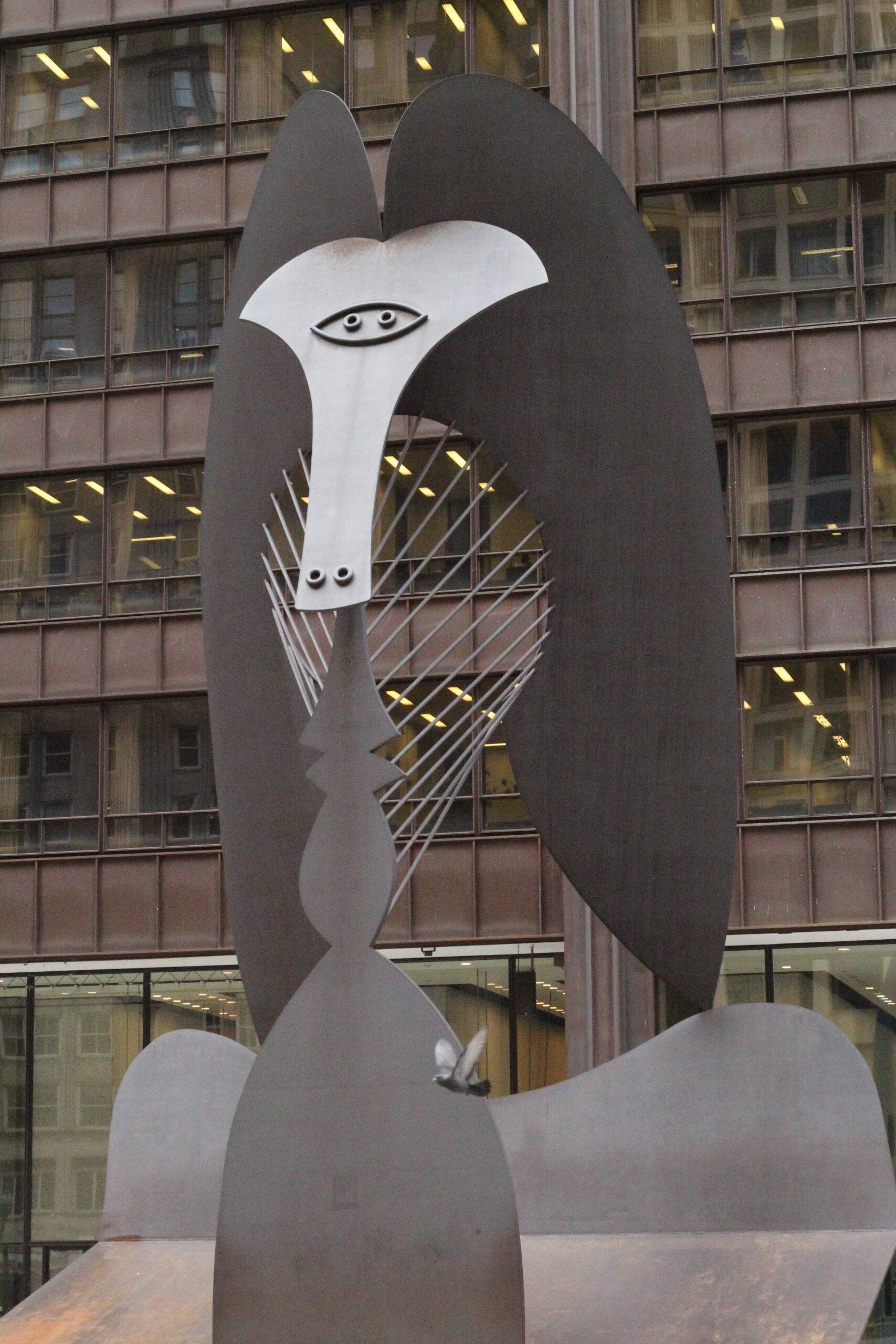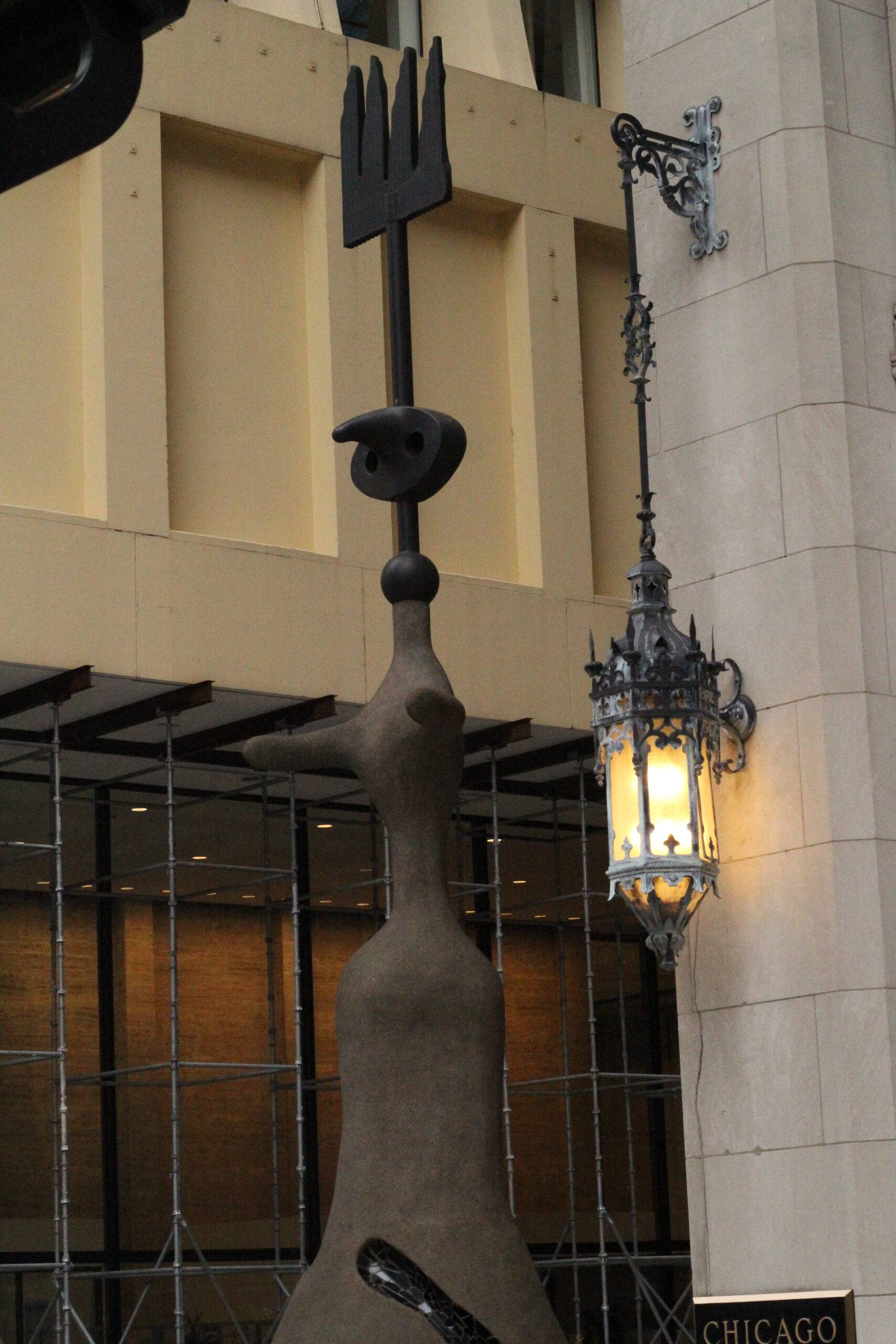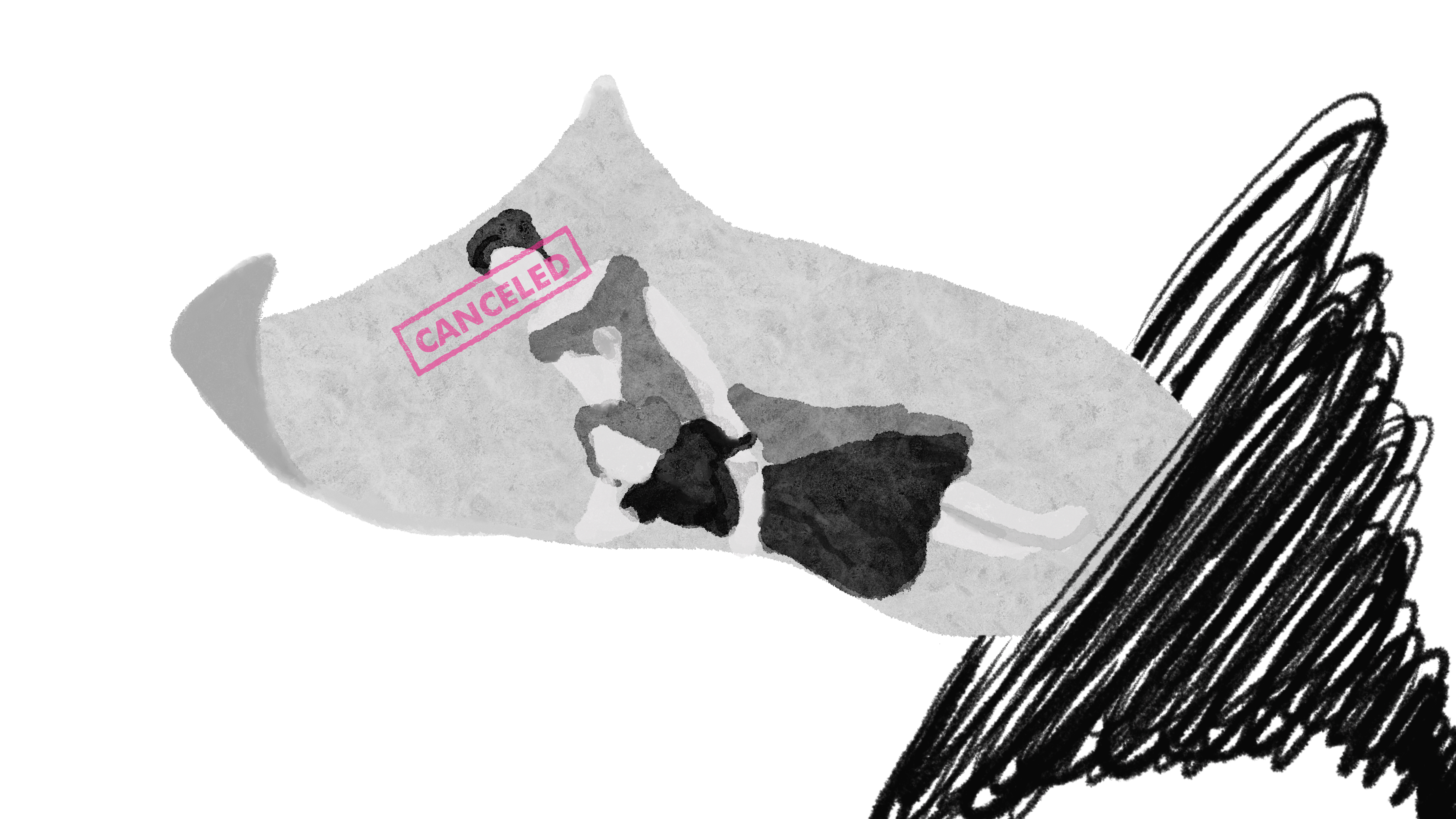When mentioning the public artworks in Chicago, I bet the piece that immediately pops up in your brain is the “Cloud Gate,” aka “The Bean.” The second one might be the two giant vertical faces-displaying glass block towers that spit water out, the “Crown Fountain” — with a name you cannot remember.
Do you know the works that precede Millennium Park’s public artworks? If not, I highly recommend you visit Chicago City Hall, Daley Plaza, Chicago Temple Building, and the Federal Plaza. If you plan to go to the Daley Plaza Christmas Market, you could take a walk around to see public sculptures by four incredibly famous artists: “Monument with Standing Beast” by Jean Dubuffet, “Untitled” by Pablo Picasso, “The Sun, the Moon and One Star” by Joan Miró, and “Flamingo” by Alexander Calder.
(Jean Dubuffet, “Picture of Monument with Standing Beast”, Photo by Amanda Reid.)
Dubuffet’s sculpture “Monument with Standing Beast,” nicknamed “Snoopy in Blender,” has the most group pictures on Instagram among the four works. This is an 8.8-meter-tall fiberglass work created in 1984.This piece was commissioned by the Capital Development Board of Illinois, and Dubuffet came up with the idea of representing a beast, and trees inspired by his painting “Hourloupe.” He coined the term “Art Brut” to represent “non-professional” artworks, and he followed this notion in his career. This informality welcomes people to interact with his sculpture.
“I aim for an art that is directly plugged into our current life,” said Dubuffet.
(Pablo Picasso, “Untitled”, Photo by Amanda Reid.)
The piece “Untitled” is an iron sculpture that is approximately fifteen meters tall. According to Picasso, it was inspired by his Afghan Hound, but many viewers interpreted it differently. The reviews on Google Maps shared tons of guesses of what this sculpture portrays. Such discussion around this topic has started since its unveiling in 1967.
Picasso was commissioned by Richard J. Daley, the architect of the Daley Center, in 1963. After it was made, Picasso decided to send it as a gift to Chicagoans without coming to the piece in person since it was unveiled.
As Picasso’s and Miró’s works are facing each other across the street, they sparked people’s comparison. “Miró’s piece is not large enough and is in a dark space so is hardly noticed,” Patricia Balton Stratton, an art historian, wrote.
(Joan Miró’s “The Sun, the Moon and One Star”, Photo by Amanda Reid.)
“The Sun, the Moon and One Star” is a twelve-meter-tall female figure made of wire, steel, concrete, and ceramic tile. Miró was commissioned by Jane Byrne, the first female Mayor of Chicago. Miró then turned his small bronze model made in 1967 into this public art piece. Gaining love from Chicagoans, they called the figure “Miss Chicago” over time.
It is undeniable that Picasso was challenged to be the first one to make a sculpture on such a big scale in Chicago, but his sculpture is neither striking nor merging into the environment. It is like a craftsman mechanically did a cubist sculpture. Miró’s piece, on the contrary, was not notable enough, but the best thing about this sculpture is that its low profile presence adds dignity to the surroundings. The visual heaviness was put on its bottom, so it looks very harmonious with skyscrapers and towers around it. Chicago Temple (the first Methodist Church) is right next to Miró’s work, and the two works are as solemn as each other. The church’s wall facing the sculpture preserved some stained glass paintings. On her dress were three colorful shapes that resonated with the colorful glass paintings.
Public art, different from installations in a gallery space, is a genre of art commissioned by specific individuals or organizations. It is still arguable the definition of public art, but at least the work itself, together with the surrounding space, should represent some collective feelings of the public.
The origin of public art can be traced back to murals and frescoes, then monuments to heroes or great people in history. According to Cher Krause Knight, author of the book “Public Art: Theory, Practice, and Populism,” different from monuments, public art should be read variously from individual to individual. It should create a “cultural democracy” instead of commemorating a “cultural hero.”
The book “Critical Issues in Public Art” criticized “the public responding.” When the general audience first sees Picasso’s work, instead of appreciating its aesthetics and its overall feelings, audiences fall into a thinking process that fits in “the frame” of “it looks like…” Audiences would use their daily lives as references. For example, the sculpture “looks like” a mosquito or “it’s an abstract art.” Harriet F. Senie argues in his essay “Baboons, Pet Rocks, and Bomb Threats” that this is an indication of a lack of “accompanying art education.”
This criticism does not apply to the other three works. While Miró’s work is also abstract, it is still comprehensible for audiences. It is not the viewers’ responsibility to improve their knowledge of art, but it is the artist’s duty to create a conversation leading audiences to make their own context. If a public art piece failed to provide a metaphorical space, people would focus on speculating artists’ intentions rather than focusing on the piece itself. The requirement of deep knowledge in art is the advocation of elitism in art, which is the opposite of “inclusive to the audience” in the notion of public art. Dubuffet’s idea of “Art Brut” in all his pieces is exactly a revolution to elitism in art.
Although some people do not perceive Miró’s sculpture as a female figure, Miró’s friend William Currie addressed this problem in the Chicago Tribune: “it is not to figure out.” He believed people can spontaneously feel its vibe. In the Chicago Tribune, seven days after the sculpture was unveiled in 1981, Hoff Linda, a writer who visited the sculpture: “There is a humanity in the gesture and curvature of her arms. That was the part that reached me, touched a chord in me somewhere.”
As I got on the bus and was approaching the last work. I saw a red horn-like protrude, and I heard someone at the back of the bus say: “Look! It’s Calder.” This is how unignorable “Flamingo” is! It totally gives people a very different fascination from Calder’s “Four Boomerangs” in the Museum of Contemporary Art Chicago or spaces like Expo Chicago. His work occupies more space than Picasso’s work in Daley Plaza, but I do not find it abrupt or heavy. For me, “Flamingo” with its surroundings is a condensed version of Chicago city.
(Alexander Calder, “Flamingo”, Photo by Amanda Reid.)
As a big fan of Picasso’s paintings, I held the highest expectation of his “Untitled.” However, I was disappointed. The overall vibe of the market is chill and happy, but there are some weird feelings with the monitor from “Untitled.” Conversely, Calder’s piece was popular, so I was skeptical about it at first, but it is actually even better — an internet user named Mike L And Jerry The Pigeon also confirmed that on the entry of “Flamingo” in Google Maps: “Beautiful in character & gives such a strong energy to the city of ‘Big Shoulders.’ I love the placement of this sculpture & that it is something for generations to enjoy.”
Imagine enlarging Calder’s “Four Boomerangs” to the same size as “Flamingo” in front of the Federal Plaza, it just does not work as well as the “Flamingo.” Imagine switching the place of the “Flamingo” between “Monument with Standing Beast.” Both sculptures will lose their impact. The two pieces situate in the right space.
Comparing the other three sculptures, Picasso’s “Untitled” might be a great museum piece, but it does not seem to fit within a public context. Public art should be both attractive and inclusive to general audiences. The abstraction that Picasso employed seemingly barred accessibility to the general public. After the work was unveiled, there was a protester holding a sign that said “colossal BOOBOO.” Being irrelevant to the city, “Untitled” is more like a self-celebrated monument for Picasso himself.
While some residents complained Picasso’s “Untitled” occupied too much space in the plaza where there was not enough space for activities. The Daley Plaza Christmas Market is ongoing around “Untitled.” A local guide, Micheal Lah, went to the Christmas Market three years ago and wrote the review for “Untitled” in Google Maps: “We were there for the open air German Christmas market. Waste of effort. It’s so overcrowded that you can barely move, let alone shop for the vendors. Save your time and go elsewhere. Never even noticed Picasso, though I’m sure it’s cool.”
Some supporters commented that Picasso’s work was too avant-garde for the city at that time. A great public piece is not for people to conjecture what the artist’s intention is, but it should be right for the place and the audience. Many articles stated that people gradually understood the idea of cubism and Picasso’s style. Looking today, Dubuffet, Miró, and Calder are all avant-garde, and Calder’s piece was just seven years younger than Picasso’s, so it is not an excuse to say that people were too conservative to appreciate Picasso’s “Untitled.” After Millennium Park’s public artworks were unveiled in the 2000s, discussions around Picasso’s work declined. It is still arguable if people have accepted it, or if they accept it for the artist’s fame.











